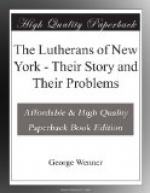It would be a congenial task to give a fuller account of these men and of Ruperti, Vorberg, Raegener, Hennicke, Waetter, Foehlinger, Koenig, Halfmann, Frey, Weissel, Beyer and others whose names and lives a few of the older preachers will recall. Perhaps some who read this book will accept the suggestion and write accounts of these pioneer workmen. What a Ministers’ Association they would have formed if we could have gotten them together into a conference to discuss the terms of agreement. But that was impossible thirty years ago.
A singularly interesting career came to a close just as I was concluding these memorial paragraphs. Dr. Charles E. Weltner died in Brunswick, Georgia, December 22d, 1917.
He was born in Wilhelmshoehe, January 28th, 1860, where his father commanded a company of soldiers in the royal castle. In his early youth he was sent to New York to meet a relative whom he never found. One Sunday morning, homeless and friendless, he accosted me after service at the door of the church. I offered him employment in my office and for several years he was an efficient helper in the educational and mission work of my parish. Although he was already suffering from defective eyesight, which not long afterward resulted in total blindness, he expressed an ardent desire to enter the ministry. Under the circumstances this seemed to be impossible, but his earnest pleas overcame every objection. In 1884 he entered Hartwick Seminary where he was graduated with honor in 1888. Unable himself to read the text books, his friends read them for him. Especially helpful to him in his studies were Professor Hiller and his wife, the daughter of the sainted Dr. George B. Miller.
Upon the completion of his course in 1888 he was ordained to the Gospel ministry and for the next four years rendered faithful service as the assistant of his pastor in Christ Church. Few that heard him would have suspected his blindness. His remarkable memory enabled him in conducting the Service to use the Bible and the Liturgy as though he could see. In the library he could go to the shelves and place his hands upon the books that he needed. His reader then supplied him with the material needed for study.
In 1893 he took temporary charge of St. John’s Church in Christopher Street.
In the Fall of 1893 he accepted a call to St. Matthew’s Church in Augusta, Georgia. His retirement in 1896 to take charge of a mission among the cotton mill operatives of Columbia, S. C., was deeply regretted not only by his congregation but by the entire city.
Thus far his ministry, however useful it had been, was only a preparation for the remarkable work he was called upon to do in South Carolina and adjoining states. The mountain whites who had been drawn into the cotton mill work of the South were illiterate and but ill prepared for their new conditions.
[illustration: “Charles E. Weltner, D.D.”]




